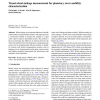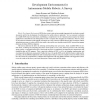TCS
2008
14 years 22 days ago
2008
From an engineering point of view, the problem of coordinating a set of autonomous, mobile robots for the purpose of cooperatively performing a task has been studied extensively o...
SWARM
2008
SPRINGER
14 years 22 days ago
2008
SPRINGER
In this paper, we study self-organized flocking in a swarm of mobile robots. We present Kobot, a mobile robot platform developed specifically for swarm robotic studies. We describe...
RAS
2006
14 years 23 days ago
2006
Mobile robots must cope with uncertainty from many sources along the path from interpreting raw sensor inputs to behavior selection to execution of the resulting primitive actions...
ENGL
2007
14 years 24 days ago
2007
—Real mobile robots should be able to build an abstract representation of the physical environment, in order to navigate and to work in such environment. We present a method for ...
JFR
2008
14 years 24 days ago
2008
The usability of mobile robots for surveillance, search and rescue missions can be significantly improved by intelligent functionalities decreasing the cognitive load on the opera...
CORR
2006
Springer
14 years 26 days ago
2006
Springer
We address the problem of autonomously learning controllers for visioncapable mobile robots. We extend McCallum's (1995) Nearest-Sequence Memory algorithm to allow for genera...
AROBOTS
2006
14 years 27 days ago
2006
Wheel sinkage is an important indicator of mobile robot mobility in natural outdoor terrains. This paper presents a vision-based method to measure the sinkage of a rigid robot whee...
AROBOTS
2007
14 years 29 days ago
2007
The process of protein crystallization is explained using the theory of robotics, particularly path planning of mobile robots. Path planning is a procedure which specifies motion ...
AROBOTS
2007
14 years 29 days ago
2007
Robotic Development Environments (RDEs) have come to play an increasingly important role in robotics research in general, and for the development of architectures for mobile robot...
AROBOTS
2007
14 years 29 days ago
2007
— A team of small, low-cost robots instead of a single large, complex robot is useful in operations such as search and rescue, urban exploration etc. However, the performance of ...


